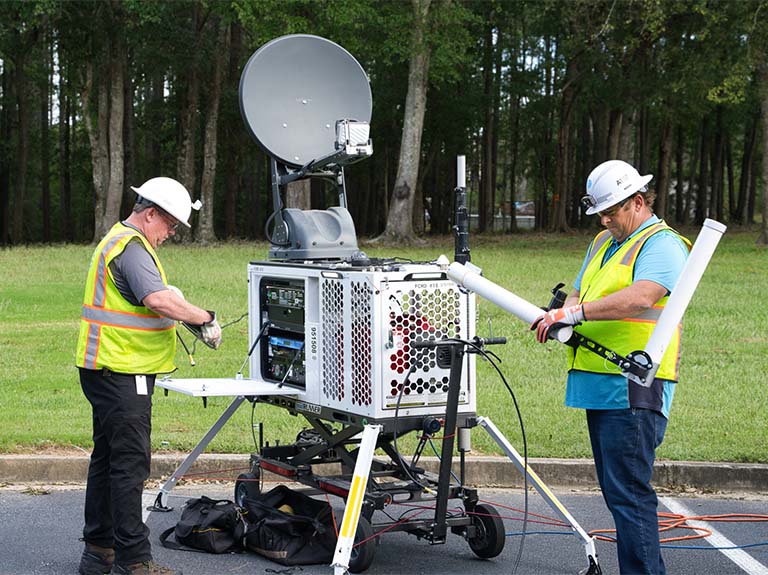FirstNet and 5G Unlock New Tools for Public Safety
Download story (PDF)
Español
FirstNet, 5G Unlocking New Tools for Public Safety
Responders Marvel at Evolution from Runners and Payphones to 3D Mapping and MegaRange
Looking back on his 40-year firefighting career, Al Gillespie recalled that when he started as a volunteer in 1977, his department allotted only one portable radio per vehicle.
“And if the radio system wasn’t working,” he said, “we used the same thing that they’ve used for the last century — runners. The Chief would say, ‘You go over there and tell them what’s going on and come back and give me their response.’”
At around the same time, Richard (Dick) Mirgon was working the streets as a rookie cop in Denver, Colorado. He always made sure he had a dime in his pocket because he never knew when he might need it to call dispatch from a payphone.
“It was pretty rudimentary back then,” said Mirgon, who worked more than 30 years in law enforcement and emergency management, now consults on public safety technology issues. “We weren’t using signal flags or anything that archaic, but we were pretty close to that.”
During their long public safety careers, both Gillespie and Mirgon have witnessed huge leaps forward in the technology first responders use to gather and share information. And both men were instrumental in the creation of FirstNet®, the nation’s first and only broadband communications platform dedicated to first responders. Despite all the advances he’s seen over the years, Gillespie said much more is on the horizon.
“Just look at how we went from steam engines to diesel-driven engines … from runners and speaking trumpets to portable radios … and from learning CPR to the paramedic programs we have today. Put all those together, and it won’t add up to the technological change that we’re seeing in public safety today and in the years to come, especially with 5G,” he said.
As 5G networks become more ubiquitous, the speedy, secure and low-latency technology is poised to unlock a wide array of new tools for public safety teams centered around the instant transmission of video, data and voice. Gillespie, who serves as president of the Public Safety Broadband Technology Association, said that FirstNet and 5G technology are igniting innovation in the public safety space, as many startups use their knowhow to develop apps and other tech tools that take advantage of the network’s capabilities. To date, some 200 apps have been certified for use on FirstNet.
One innovation that’s creating particular excitement is called “Z-Axis.” It allows public safety to not only pinpoint responders on a map like you would through any GPS-based method, but also provides the third dimension of a specific location — their elevation.
“For fire service,” Gillespie said, “it’s important for us to be able to locate where somebody is in a building — either which floor they’re on or where they are on that floor.”
Another new FirstNet-exclusive tool, called MegaRange™, involves equipping public-safety vehicles with special radio equipment that extends the range of network connectivity, especially in areas at the edge of signal coverage (think places where you have only one bar of service). And it’s a direct result of Band 14, public safety spectrum.
“We can stretch communications into areas we had no idea we could get to,” Gillespie said. “Where they were right on the edge of communications, now they’re right in the middle of it.”
Chris Moore, a former San Jose police chief who works as a public-safety consultant today, added that with wireless connectivity, first responders are now able to create a virtual corridor of care from an incident scene straight to the emergency room.
“You can not only run EKGs, you can run all sorts of telematics for vital signs back to the hospital,” he said. “You have paramedics who can administer drugs. The save rate for these traumatic accidents is a whole lot better than it used to be because of our ability to communicate with the base hospital.”
Moore also said wearable technology, such as body cameras, will continue to grow more sophisticated in the data they collect and the way they transmit and share it. And he added that other capabilities, such as rapid DNA testing, are already in play and continue to further develop. Rapid DNA testing would give law enforcement the ability to collect a DNA sample in the field, transmit the data and ID the perpetrator in a matter of minutes.
“With sexual assaults, for example, sometimes it takes a year to get the test kits identified through a lab,” he said. “An average rape suspect strikes 12 victims before they get captured. With rapid DNA testing, we have the potential to stop the offender after their first crime.”
Gillespie added that it’s remarkable to see how quickly technology is evolving and delivering impacts he and other public-safety veterans never imagined.
“We hoped things like this would happen,” Gillespie said. “But some of them, we didn’t even know to think about at the time.”
FirstNet and the FirstNet logo are registered trademarks and service marks of the First Responder Network Authority.
As seen in The New York Times



